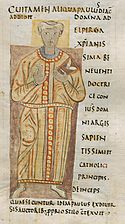Aistulf follis 80000860
Lombards: Lombardy. & Tuscany. Aistulf. 749-756.
- Æ Follis (1.43 g, 6h). Ravenna mint. Struck 751/2.
- [D] N IST VLF[VS REX], facing crowned and draped bearded bust, holding globus cruciger in right hand; crown topped with cross
- Large M; cross above, [A]/N/N/[O] I across field, RAV below.
- Bernareggi -; Ranieri 848 (same obv. die as illustration); BMC Vandals -; MEC 1, 324.
- Good VF, red-brown patina. Very rare.
- Appointed Duke of the border Duchy of Friuli when his brother Ratchis became king of the Lombards in 744, Aistulf himself became king in 749 when Ratchis was forced to abdicate. During his tenure, Aistulf attempted to expand Lombardic interests in Italy by raiding both the Byzantine exarchate of Ravenna and the territories of the papacy. In 751, the Lombards took Ravenna and began to pressure Rome. In response, Pope Stephen II turned to the de facto Frankish king, Pepin 'le Bref' (the Short) for assistance. In return for a pontifical recognition of his crown, Pepin crossed the Alps, defeated Aistulf, and forced the Lombardic king to relinquish those territories he had extracted from the papacy. Now, much reduced, Aistulf spent the remaining few years of his reign in the pursuit of pleasure. In 756 he was killed in a hunting accident. With his death, the Lombardic kingdom lost even more territory and influence in Italy in the face of an increasing alliance between the papacy and the Carolingians.
Relevante Bilder
Relevante Artikel
AistulfAistulf war König der Langobarden von 749 bis 756. .. weiterlesen
Diodato IpatoDiodato Ipato, auch Teodato Ipato oder in den zeitlich näheren Quellen Deusdedit, war nach der traditionellen, also der staatlich gesteuerten Geschichtsschreibung Venedigs, der 4. Doge der Republik Venedig. Nach heutigem Wissensstand war er der zweite Doge und Sohn des wohl ersten Dogen Ursus (Orso), der um 737 im Verlauf von Kämpfen innerhalb der Lagune von Venedig ermordet wurde. Diodato wurde im Zuge der damit zusammenhängenden Kämpfe vertrieben, kehrte aber zwei Jahre später wieder in die Lagune zurück. Er regierte dort ein Jahr lang als Magister militum und war Doge von etwa 742 bis 755 mit Residenz in Alt Malamocco (Methamaucum). Damit war das Dogenamt dauerhaft etabliert, wenn sich auch sein Charakter im Laufe des folgenden Jahrtausends überaus stark veränderte. .. weiterlesen









